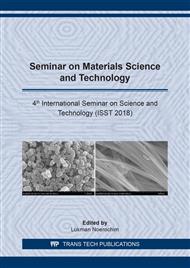p.221
p.228
p.234
p.240
p.246
p.251
p.257
p.263
p.270
The Effect of Deposition Time on Ag-Zn Thin Film Forming Using RF Sputtering for Antimicrobial Coating Orthopedic Devices
Abstract:
Stainless steel 316L is one of material that commonly used as medical bone implants. The needs of bone implants is quite high, even increases each year. However, bone implants itself has risks associated with bacteria and fungi. Various microorganisms can act as pathogens that have the abilityto stick to the surface of the implant material and forms biofilms that initiating infection inside the body. The method that can be used to prevent the infection is surface modifcation by applying antimicrobial coating on the implant material surfaces. Scientifically, silver (Ag) and zinc (Zn) are materialsthat have good antibacterial and biocompatibility properties. In this study, AgZn was deposited on SS 316L substrate using Radio Frequency (RF) Sputtering method. The aims of this study are to analyze the effect of the deposition time (15 minutes till 45 minutes). The surface area ratio of target material is 80% Ag 20% Zn. The morphology, mechanical properties, and antimicrobial properties of the thin film were studied. The variations of deposition time cause the difference in AgZn thin film thickness deposited on the surface of the substrate. The thickest thin film was obtained at 45 minutes deposition time, which is 1.61 μm thickness. Deposition time can also increase surface roughness and antimicrobial ability due to agglomerization of Ag and Zn on the surface of the sample. The best antimicrobial ability is found at deposition time of 45 minutes, resulting 11,3 mm of inhibition zone width
Info:
Periodical:
Pages:
246-250
Citation:
Online since:
July 2019
Price:
Сopyright:
© 2019 Trans Tech Publications Ltd. All Rights Reserved
Share:
Citation:


